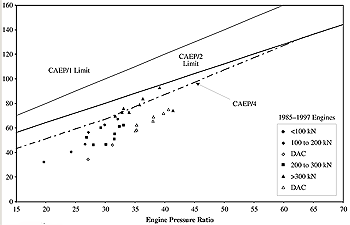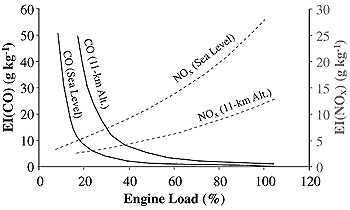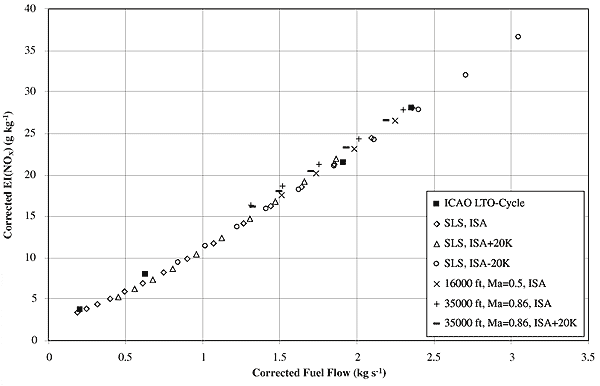7.6.4.3. Oxidation Products of Secondary Combustion Species (HNO2, HNO3,
SO3, H2SO4, H2O2, HNO)
|

Figure 7-29: Engine NOx characteristic values of
Dp/Foo for the ICAO LTO cycle, and changes in
regulatory limits.

Figure 7-30: Emissions characteristics of a fan engine
versus load at sea level and in flight at 11 km.
|
Modeling results (Brown et al., 1996; Lukachko et al., 1998) and, for SOxO,
initial measurements (Arnold et al., 1992, 1994, 1999; Fahey et al., 1995a,b;
Miake-Lye et al., 1998) indicate that significant changes in the levels of these
species are possible as their source gases are oxidized. These changes can be
important with respect to atmospheric impact (see Chapters
2 and 3). However, most of the important chemical
and fluid-mechanical effects remain unexplored. It is known, however, that strong
non-linearities in the chemistry (based on as-yet unvalidated chemical models)
can be accentuated by complex fluid-mechanical effects such as those associated
with viscous boundary layersand wakes and blade cooling (Lukachko et al., 1998).
Figure 7-27 shows an example of this process: Two
different modeling results are compared for a single blade row such as that
shown in Figure 7-24. The first modeling result
takes account of spatial temperature nonuniformity associated with blade cooling,
whereas the second is an averaged, one-dimensional representation of the flow
path. SOxO oxidation in the blade row is enhanced when blade cooling is modeled.
Changes in many secondary combustion species from presumably negligible levels
after leaving the combustor cannot yet be predicted with sufficientaccuracy
for assessment needs (Dryer et al., 1993; Miake-Lye et al., 1998). The existing
experimental database for these species is insufficient to validate or improve
current model predictions. For example, although models and initial measurements
suggest that significant oxidation of SO2 to SO3 occurs within the engine, the
models do not correctly predict the variation in the fraction of sulfur oxidized
as fuel sulfur level is changed-suggesting that an unknown oxidative mechanism
may be involved (Schumann et al., 1996; Danilin et al., 1997; Kärcher and Fahey,
1997; Miake-Lye et al., 1998). Thus, current understanding is not mature enough
to provide accurate initial conditions for aerosol formation models and subsequent
atmospheric modeling downstream of the engine exit.
7.6.4.4. Reactive Species (O, OH, HO2, SO, H2, H, N, CH)
Current chemical models assume the radicals N and CH to be negligible for current
technology engines, and their influence on the course of post-combustion chemistry
has been ignored. The validity of this assumption has not been assessed, however,
and as combustion temperatures increase in future engines these constituents
(as well as the others) may become more important. O and OH are considered to
be the dominant oxidizing species within current modeling assumptions (HO2 levels
remain less important), and orders of magnitude change are possible in these
reactive species throughout the turbine and nozzle. Their evolution is very
sensitive to chemical kinetics and species initialization at the combustor exit,
and they are influenced by flow nonuniformities in the turbine and nozzle to
a similar extent as the oxidation products. Prediction of their levels with
sufficient accuracy for assessment needs is beyond currently validated capabilities,
and the existing experimental database is insufficient to validate models. Furthermore,
recent modeling studies (Yu and Turco, 1997, 1998) have implicated chemi-ions-a
product of flame ionization in the combustor-as important in the growth of volatile
particles after the exhaust leaves the engine. No measurements of ion levels
at the engine exit have been identified; few measurements downstream of the
exit exist (Arnold et al., 1994, 1999), and only simple estimates of the recombination
inside the engine have been attempted to date, so the uncertainty in the emission
levels of chemi-ions is very high.
Pressure and temperature and residence times change over relevant ranges of
operating conditions and engine cycles, and the chemical processes are expected
to change as a result. Generalizations regarding the exhaust constituents described
above are not expected to change significantly over cruise conditions and even
over the broader operating conditions representative of the landing/take-off
cycle. However, changes in exit speciation are expected for the oxidative products
and radical species that depend non-linearly on combustor exit concentrations
and local conditions. Only limited research has been carried out on this topic
(Hunter, 1982; Brown et al., 1996; Lukachko et al., 1998).
Table 7-7 provides a simplified status summary
of the confidence attached to current modeling and measurements of emissions
emerging from engines. Reducing uncertainties in the oxidation products of secondary
species and in reactive species will require additional new measurements, as
well as increased physical understanding of exhaust species oxidation in the
turbine and nozzle.
|

Figure 7-31: Variation in NOx emission index with engine
load and ambient conditions
(CF6-80C-type engine modeling).

Figure 7-32: Emission indices and fuel flow corrected
for ISA SLS conditions.
|
|